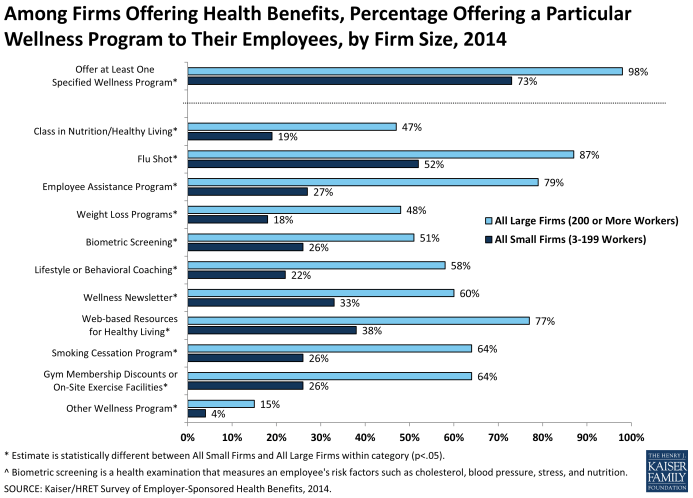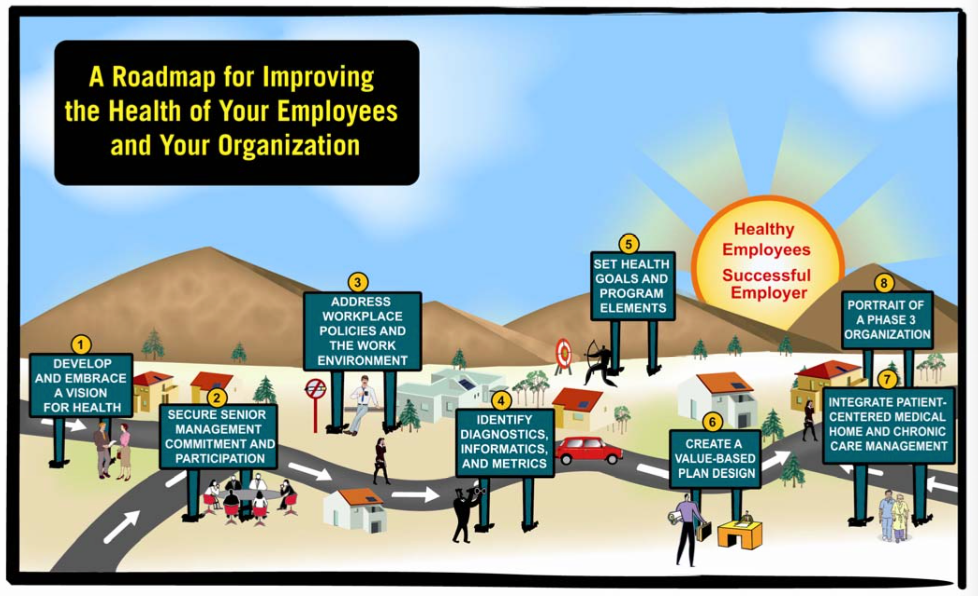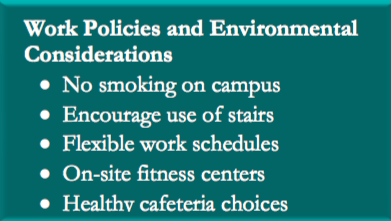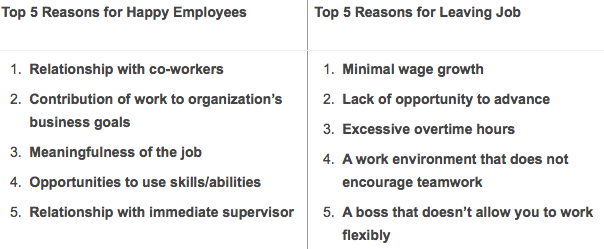It Takes a Village
Workplace Health -> Additional ContentAdditional Content
While numerous publications describe examples of workplace wellness programs, such programs need to happen within the context of an organization that also supports employee satisfaction and a healthy work environment. The Kaiser Family Foundation/Health Research & Educational Trust’s 16th annual Health Benefits Survey of 2,000 large and small organizations described in some detail the types of wellness programs offered in various sized companies. The Roadmap for a Healthier Workforce produced by the Change Agent Workgroup shows the signposts of an organization that creates a healthy workplace while supporting employee wellness programs. As important as it is to offer exercise programs, gym discounts and biometric screenings, it is equally important to address employee behavioral health, meaning mental health and substance use issues, such as depression or alcoholism. Whatever programs are offered, it should be made clear that they are voluntary, and companies should not unfairly coerce employees to participate.
2014 Health Benefits Survey
The Kaiser Family Foundation/Health Research & Educational Trust’s 2014 Health Benefits Survey of 2,000 small and large employers found that:
- 98 percent of large employers (at least 200 employees) and 73 percent of smaller ones (3-199 employees) offer at least one wellness program as part of their health benefits package, such as:
- Weight loss programs
- Biometric screenings
- Gym membership discounts or on-site exercise facilities
- Smoking cessation programs
- Lifestyle or behavioral coaching
- Classes in nutrition or healthy living
- Web-based resources for healthy living
- Flu shots or vaccinations
- Employee assistance programs (EAP)
- Wellness newsletters
- Among large firms offering health benefits, 51 percent offer biometric screenings to measure workers’ health risks.
- Among companies that offer wellness programs, 36 percent of large employers and 18 percent of small ones provide a financial incentive for their employees to participate, whether a lower premium or deductible, a larger contribution to a tax-preferred savings account, or a gift card, cash or merchandise.
- 8 percent of large firms reward or penalize workers financially based on their biometric outcomes, such as body mass index or managing cholesterol levels. Fifty-eight percent of these had an incentive worth less than $500, and 42 percent had a reward of $500 or more.
The figure below shows the percentage of large and small businesses that offered each type of program.
 Source: Kaiser/HRET 2014 Employer Health Benefits Survey, Section 12: Wellness Programs and Health Risk Assessments.
Source: Kaiser/HRET 2014 Employer Health Benefits Survey, Section 12: Wellness Programs and Health Risk Assessments.
Roadmap for a Healthier Workforce
Employer Health Asset Management: A Roadmap for Improving the Health of Your Employees and Your Organization (2009), produced by the Change Agent Workgroup, describes seven main elements for achieving a healthier workforce. It helps organizations evolve from articulating a basic desire for a healthier workforce (Phase 1), to a comprehensive employee health strategy (Phase 3). The end of the report has case studies of organizations that have excelled in each area.
 Source: Employer Health Asset Management, Roadmap for Improving the Health of Your Employees and Your Organization, 2009.
Source: Employer Health Asset Management, Roadmap for Improving the Health of Your Employees and Your Organization, 2009.
The Employer Health Asset Management roadmap involves seven main elements. Each of the seven elements requires involvement and accountability from employers and employees. They are:
 Develop and Embrace an Organizational Vision of Health: Recognize the business value of health and establish goals that fit your organization’s culture.
Develop and Embrace an Organizational Vision of Health: Recognize the business value of health and establish goals that fit your organization’s culture.- Senior management participation and commitment: Assure the commitment of senior management to improve the overall health of the workforce and demonstrate positive health behaviors themselves.
- Workplace policies and the work environment: Write and publish workplace policies and create an environment that support them (see text box for examples).
- Diagnostics, informatics and health metrics: Collect medical and pharmacy claims data to analyze organization-wide employee health and report changes regularly.
- Health goals and program elements: Seek continual improvement in health outcomes and use incentives to increase participation in health improvement programs.
- Value-based plan design: Design the program in a way that offers financial incentives for actions that save money for the company or for health plans, such as completing health risk assessments; non-smoking status; medication adherence; weight management; and management of chronic conditions.
- Patient-centered medical home (PCMH)/chronic care management: Support a patient-centered medical home model since it not only provides primary care services, but also wellness and prevention services.
What makes employees happy at work?
Organizations with workplace wellness programs also need to focus on how to increase employee satisfaction so that employees feel happy and healthy while they are at work. On their Workplace Wellness webpage, Mental Health America reports that less than one-third of Americans are happy with their work, and that half of the workforce is “checked-out.” If an employee is unhappy, it will work against progress to become physically and mentally healthy in workplace wellness programs. Mental Health America offers a Work Health Survey to help people assess their own happiness with their job. The top five reasons for happy employees, and the top five reasons for leaving a job, are shown below.

Workplace Behavioral Health
According to the CDC, depression is a major cause of disability, absenteeism, and productivity loss among adults, but it is difficult to identify. Employees may not seek treatment because they worry they might lose their job or that other people might find out about it. It is a complex condition that is influenced by both work and non-work factors. Evidence is beginning to accumulate linking work organization with depression and other mental health problems. Studies of diverse occupations suggest that high job demands, low job control and lack of social support in the workplace may be associated with depression. More studies are needed to identify interventions that effectively target these risk factors. However workplaces can implement a number of strategies to support employee mental health such as:
- Hold depression recognition screenings.
- Place confidential self-rating sheets in cafeterias or break rooms, or on bulletin boards.
- Promote greater awareness through employee assistance programs.
- Train supervisors to recognize depression.
- Ensure workers’ access to needed psychiatric services through the company health insurance plan(s).
- Encourage employees to engage in physical activity to decrease depression symptoms.
- Use employee surveys to ascertain information about co-worker relationships or conflicts, job demands, and the level of support (or lack thereof) provided by supervisors and colleagues. Use this information to develop training, communication and other intervention to improve the mental health environment.
The CDC reports that alcoholism and substance misuse among employees create additional costs for employers due to absenteeism, decreased productivity, turnover, accidents and increased health care costs. The following employee behaviors indicate a possible problem with alcohol or drug use:
- A pattern of poor quality or quantity of work
- Attendance problems
- Problems related to client or customer interactions
Employee assistance programs (EAPs) can offer information and referrals to community agencies to receive counseling or treatment for substance abuse problems. EAPs can also play a role in educating employees on recognizing signs and symptoms of misuse in themselves and others through brochures, education campaigns, and worksite health fairs.
The Partnership for Workplace Mental Health works with businesses to ensure that employees and their families living with mental illness, including substance use disorders, receive effective care. Untreated mental illness in the workplace increases absenteeism, decreases productivity, and drives up healthcare and disability costs. In many cases, however, treatment can be very effective. The Partnership offers extensive information and resources on a number of topics, including anxiety disorders, depression, post-traumatic stress disorder, suicide prevention, and alcohol use disorders. They also have a link to an alcohol cost calculator and a substance use disorder calculator, which are online tools to estimate the prevalence and cost of these problems on a business by plugging in the demographics of a company’s workforce.
Voluntary or Coercive?
Some feel that employers cross the line when they “pry” into an employee’s health status and reward or punish them based on survey or screening results. Employers might use questionnaires that ask questions like how many drinks an employee has per week, or whether a woman is planning to become pregnant. Employers may also weigh employees to determine body mass index, or require blood tests showing cholesterol or blood sugar levels. Although federal rules require wellness programs to be voluntary, a third of large employers use financial incentives – reward or penalties – depending on whether or not a person participates and/or shows improvement (Julie Rovner, Kaiser Health News, December 11, 2014).
“When employers can charge you a couple thousand dollars more for refusing to give private medical information, [that] doesn’t sound very voluntary to me.” –Samuel Bagenstos, Professor, University of Michigan Law School, (Quoted here)
Al Lewis, a writer and outspoken critic of workplace wellness programs, explains in a Health Affairs blog (11-25-2014) that he does not believe these programs really save money for the company, but rather increase the cost of health programs and cause overutilization of screening and check-ups in generally healthy working age adult populations.
